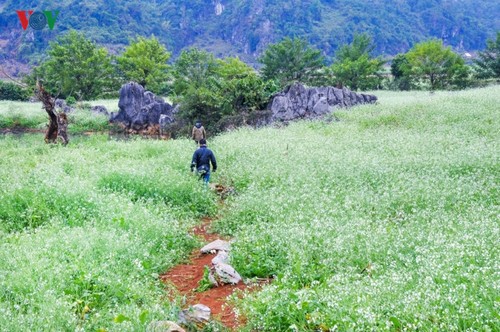 The most beautiful destinations in Moc Chau are found in the valleys and villages of Ang, Na Ka, Pa Phach, Phieng Canh, Ngu Dong, and On. The most beautiful destinations in Moc Chau are found in the valleys and villages of Ang, Na Ka, Pa Phach, Phieng Canh, Ngu Dong, and On. |
Motorbikes are the best way to traverse the bumpy, rocky roads to the fields and villages around Moc Chau. Spring is a perfect time to visit, when Moc Chau is an explosion of colors: pink peach blossoms, yellow and mustard chrysanthemums, red poinsettias, and white apricot, peach, and plum blossoms, set against a green background of forests and tea farms. There are also lots of orchids.
What else attracts visitors? Here are a few things.
“The weather here is very distinctive from other places. I feel like there are four seasons in a day,” a visitor said.
“Moc Chau is beautiful not just in a specific season but all year long. The plateau shines in spring when apricot, plum, and peach blossoms are in full bloom. Winter is when the wild sunflowers boast their typical yellow over the immense hills. Visitors to Moc Chau can enjoy the most of local traditional ethnic activities,” another added.
“What I love most about Moc Chau is the fresh cool air in the morning that makes me feel close to nature. I also love picking tea buds which are used later to make tea at home. It’s really enjoyable,” said a tourist.
|
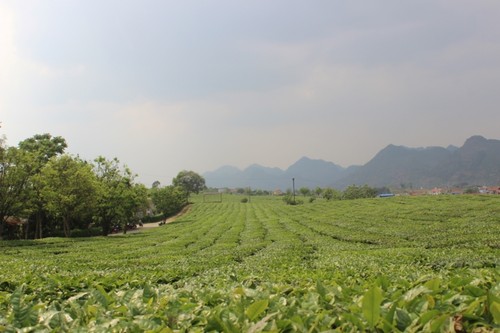 Endless tea hills in Moc Chau (Photo: VOV) Endless tea hills in Moc Chau (Photo: VOV)
|
Tea hills in Moc Chau are endless inspiration for photographers and hikers. Moc Chau Plateau has a temperate climate, topography, and soil suitable for growing tea. Heart-shaped tea hills have become attractive tourist attractions, drawing a lot of visitors, especially young people. Visitors can admire immense green tea plots and rent or buy the colorful traditional costumes of local ethnic groups for photos.
In addition to the immense tea fields and flower gardens, there are other interesting spots to visit in Moc Chau, according to Nguyen Nhat Lam, Director of the Viettrip Travel Company.
“Other tourist attractions in Moc Chau include Doi (Bat) Cave and Dai Yem waterfall. Backpackers are also interested in the Long Sap border gate, which leads them through large maize fields and ethnic villages where locals are still practicing their traditional culture,” Lam said.
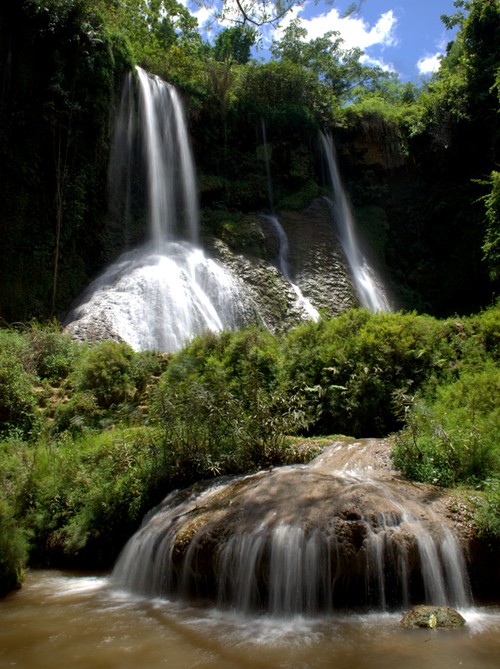 Dai Yem water fall (Photo: dulich.sonla.gov.vn) Dai Yem water fall (Photo: dulich.sonla.gov.vn) |
Delicious dishes in Moc Chau are made of buffalo or cow. One of the favorite dishes here is “tinh top” which is made of brook fish seasoned with “cham cheo”, a typical spice of ethnic people in northern Vietnam.
Visitors to Moc Chau have many accommodation options, according to Mr. Lam.
“Depending on the size and interests of each travel group, tourists can choose to stay at hotels in downtown Moc Chau or in stilt houses in Ang village, where they can also enjoy BBQ and a campfire. Tourists now favor a homestay where they can live, eat, and talk with locals to learn about their daily life and traditions," he added.
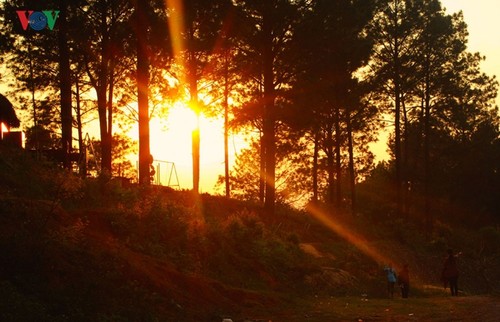 Ang village at sunset. Ang village at sunset. |
Ang village in Dong Sang commune pioneered community-based tourism in Son La province. Locals have upgraded traditional stilt houses into communal guest houses, planted flowers and vegetables, and organized tours. Ha Van Quyet, a provider of a community-based tourism service in Ang village, told VOV: “Most tourists to Moc Chau love the homestay service, the beautiful nature, and the clean farm produce. They want to experience in farming with the locals. So we have built bungalows on the hills near our cultivated land. This is, I think, the most effective marketing method.”
The Thai minority people living in Ang village are still making their traditional handicrafts, including weaving and embroidery, and teach visitors these crafts. A trip is not complete without tasting the local cuisine: a veal dish in a pan, a bowl of taro soup, and home-grown vegetables. Lo Thi Luong says the most typical dish of the Thai people is grilled moss taken from the brooks. She talked about how to make it: “We take out all the grit and clean the moss with water. Then we squeeze and dry the moss. We season it with garlic, ginger, onion, and herbs. A handful of moss is wrapped in green leaves and grilled.”
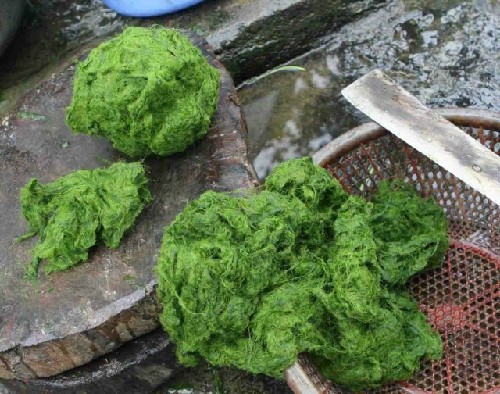 Moss is taken from the brooks to make a delicious dish. (Photo: dulichdienbien.com.vn) Moss is taken from the brooks to make a delicious dish. (Photo: dulichdienbien.com.vn) |
A unique culture, a charming landscape, and friendly locals have made Ang village a required stop when you come to Moc Chau. A traveler commented: “This is the first time I’ve been to Moc Chau with my friends and teachers. I went to the tea farm and the pine hills and enjoyed our meals together in the stilt house. It’s really interesting. I love the cool air and hospitable villagers.”
Another talked about her experience in Moc Chau: “It’s really cool in Moc Chau. The weather here is similar to that of Dalat in the Central Highlands. I like the orchids, Dai Yem waterfall, and the tea farms.”
A tourist shared how he is interested in his stay in Ang village: “I love the atmosphere here. Ang village has become more beautiful and tourism service has improved since the last time I was here. The villagers are so friendly. All gave me a great impression of Moc Chau.”
Let’s continue on to another destination in Moc Chau that visitors pass on their way from the central town to Ang homestay village. It’s Doi (Bat) cave.
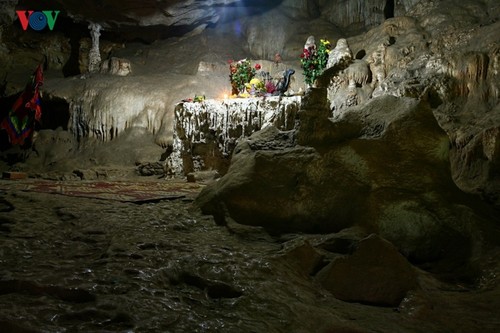 Bat cave in Moc Chau is a scenic spot and a historical relic. Bat cave in Moc Chau is a scenic spot and a historical relic. |
Doi cave, also known as Son Moc Huong cave, is 6 kilometers northeast of Moc Chau. The cave entrance can only be reached by climbing 240 steps. Once you’re inside, the impressive 6,000-square-meter limestone cave overwhelms you.
Climbing the mountain while listening to distant birds and gushing streams is a relaxing experience.
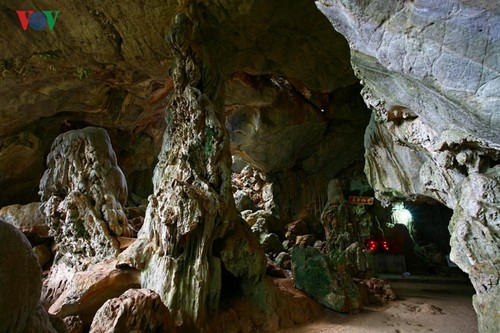 The cave's entrance looks like a dragon's mouth. The cave's entrance looks like a dragon's mouth. |
Lu Thi Hong Mai, one of the first Ang villagers to provide tourism services, says the Thai originally called this cave “Sa Lai”, which means “water” in their language. People later gave it the name “Doi” as there are flocks of bats living inside the cave.
“Legend has it that the God of Hell once sent his troops to arrest a very beautiful lady who was bringing rice to her father. The father waited until noon but never saw his daughter so he told her lover something had happened to her. The man fought the God of Hell (also called the Naga) through Doi cave and chased the Naga to Ang village, where he triumphed and took his beautiful lover back,” Mai explained.
The tour guide is recounting another legend about the formation of the cave. A dragon flying to the East Sea was enchanted by the beauty of this land and forgot all about the East Sea. He landed and made this mountain range his home, turning the area into a magical landscape of mysterious colors: white as crystals in the morning, blue as sapphires at midday, pink as rubies in the afternoon, deep purple in the twilight. On the day the dragon finally left the mountain range, he dropped seven jades from his mouth and turned them into mountains to thank the land and people of Moc Chau. In one of the jades, Doi Cave is situated.
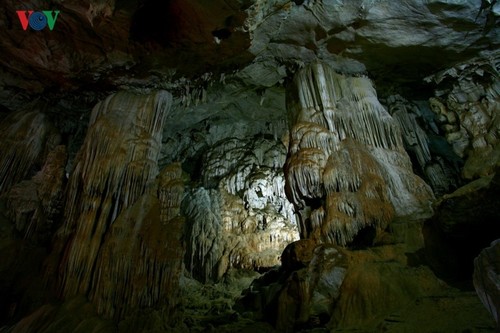 Stalactites inside Bat cave Stalactites inside Bat cave |
The interior of the cave is stunning. From the ceiling of the cave hang twinkling seven-colour stalactites, some of them 20 meters long. They look like roots of an ancient banyan-tree. Others look like Buddha, elephant, tiger, lion, eagle, and masses of cloud. In the middle of the cave is the magnificent palace of a princess. On the cupola of the cave are many small rocky holes which teem with bats. Drops of water drip from the stalactites, creating a melodious sound.
A couple from Hoa Binh province are delighted by the beauty of Doi cave: “There are many sparkling stalactites and the echoing sound of nearby streams. The cave is beautiful. This cave is magnificent and has made a big impression on me.”
The Government recently approved a plan to create a Moc Chau national tourist site until 2030, containing a resort, an ecotourism center, and an entertainment center, spanning 200,000 ha in the two districts of Moc Chau and Van Ho. The site is expected to attract 1.6 million visitors by 2020 and 5 million by 2030.